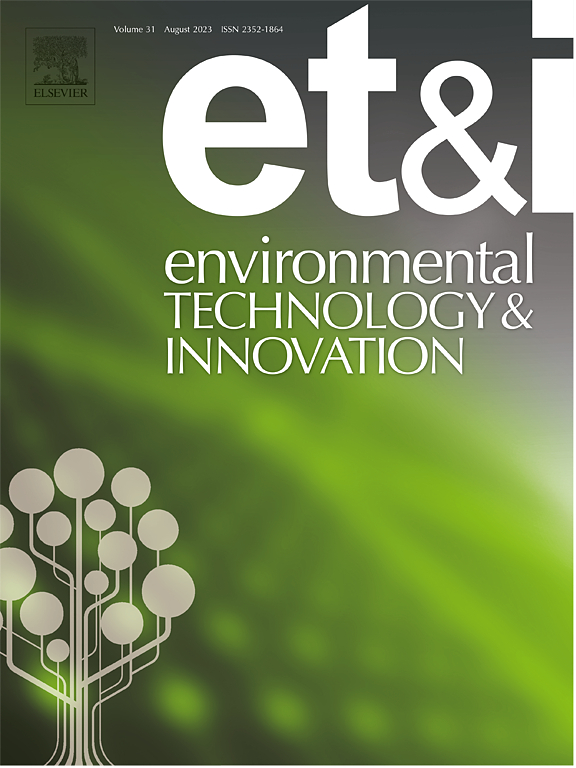热带植物和智能绿墙对封闭室内细颗粒物(PM2.5和PM0.3-1.1)的减排效果
IF 6.7
2区 环境科学与生态学
Q1 BIOTECHNOLOGY & APPLIED MICROBIOLOGY
引用次数: 0
摘要
本研究探讨了植物种类在减少环境细颗粒物(PM)方面的有效性。在封闭系统室中,10种被试物种中,对PM2.5的降低率最高的是鸡血花(Spathiphyllum cannifolium)(26 %),其次是堇叶肾松(22 %)和小红花(17 %)。牛油果的优异表现可能与其叶表面有沟槽、叶面积大、叶两侧有气孔等形态特征有关。在一个充满森林叶片燃烧产生的颗粒物的64 m³ 室中,评估了结合这10种植物的智能绿墙在减少PM2.5和细颗粒物(PM0.3-9.0)方面的效率。室内PM2.5的初始浓度约为300 µg/m³ 。一间有漂亮绿墙的房间和一间空房间(对照)是研究的两种情况。温度范围为26.5℃~ 28.5℃,相对湿度范围为39.5 % ~ 40.5 %,光照强度范围为2620 ~ 2650 lux。结果表明,在没有智能绿墙的空房间或受控条件下,PM2.5浓度在1小时内从300 µg/m³ 降至121 µg/m³ 。智能绿墙在一小时内将PM2.5从300 µg/m³ 降低到89 µg/m³ 。干叶燃烧初期,气溶胶浓度峰值接近20万粒/cm³ ,其中细颗粒物(PM0.3-0.65)占多数。智能绿墙减少了39 - 41%的细颗粒物 %。虽然这表明在微型城市环境中有可能减少PM,但实际效果将取决于环境条件。本文章由计算机程序翻译,如有差异,请以英文原文为准。
Efficiency of tropical plants and smart green wall on reduction of fine particulate matters (PM2.5 and PM0.3–1.1) in a closed-system chamber
This study investigates the effectiveness of plant species in reducing ambient fine particulate matter (PM). Among 10 tested species in a closed-system chamber, Spathiphyllum cannifolium achieved the highest PM2.5 reduction (26 %), followed by Nephrolepis cordifolia (22 %) and Tabernaemontana divaricata (17 %). The superior performance of S. cannifolium is likely attributed to its morphological features, including a grooved leaf surface, large leaf area, and stomata on both leaf sides. A smart green wall combining these 10 plant species was evaluated for its efficiency in reducing PM2.5 and size-fractionated PMs (PM0.3–9.0) in a 64-m³ chamber filled with particulate matter generated from forest leaf burning. Initial PM2.5 concentrations in the chamber were approximately 300 µg/m³ . A room with smart green walls and an empty room (control) were the two situations investigated. The temperature ranged from 26.5°C to 28.5°C, relative humidity from 39.5 % to 40.5 %, and light intensity ranged from 2620 to 2650 lux. The results showed that, PM2.5 concentrations in empty rooms or controlled condition without smart green walls were reduced from 300 µg/m³ to 121 µg/m³ within one hour. The smart green wall reduced PM2.5 from 300 µg/m³ to 89 µg/m³ within one hour. In the initial stage of dry leaf burning, the aerosol concentration peaked at nearly 200,000 particles/cm³ , with fine particles (PM0.3–0.65) accounting for the majority. The Smart Green Wall reduced fine particles by 39–41 % of the total count. While this suggests some potential for PM reduction in micro-scale urban settings, real-world effectiveness would depend on environmental conditions.
求助全文
通过发布文献求助,成功后即可免费获取论文全文。
去求助
来源期刊

Environmental Technology & Innovation
Environmental Science-General Environmental Science
CiteScore
14.00
自引率
4.20%
发文量
435
审稿时长
74 days
期刊介绍:
Environmental Technology & Innovation adopts a challenge-oriented approach to solutions by integrating natural sciences to promote a sustainable future. The journal aims to foster the creation and development of innovative products, technologies, and ideas that enhance the environment, with impacts across soil, air, water, and food in rural and urban areas.
As a platform for disseminating scientific evidence for environmental protection and sustainable development, the journal emphasizes fundamental science, methodologies, tools, techniques, and policy considerations. It emphasizes the importance of science and technology in environmental benefits, including smarter, cleaner technologies for environmental protection, more efficient resource processing methods, and the evidence supporting their effectiveness.
 求助内容:
求助内容: 应助结果提醒方式:
应助结果提醒方式:


